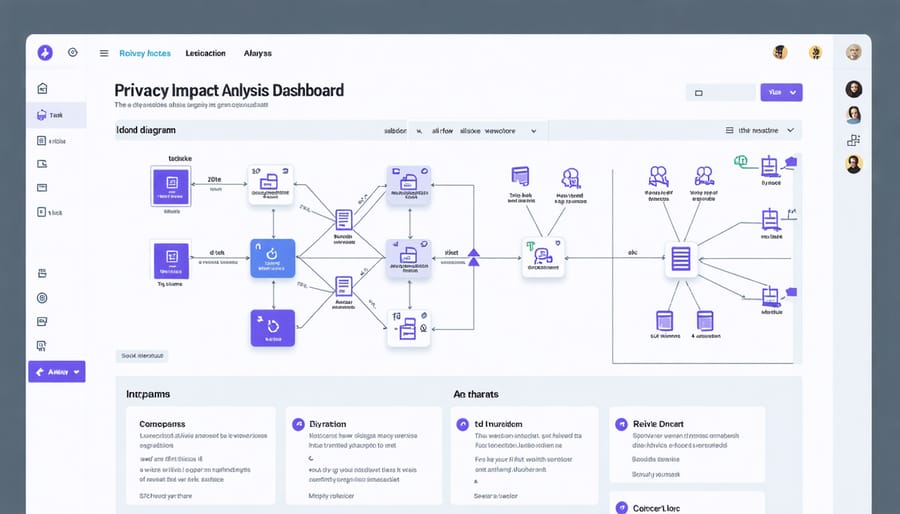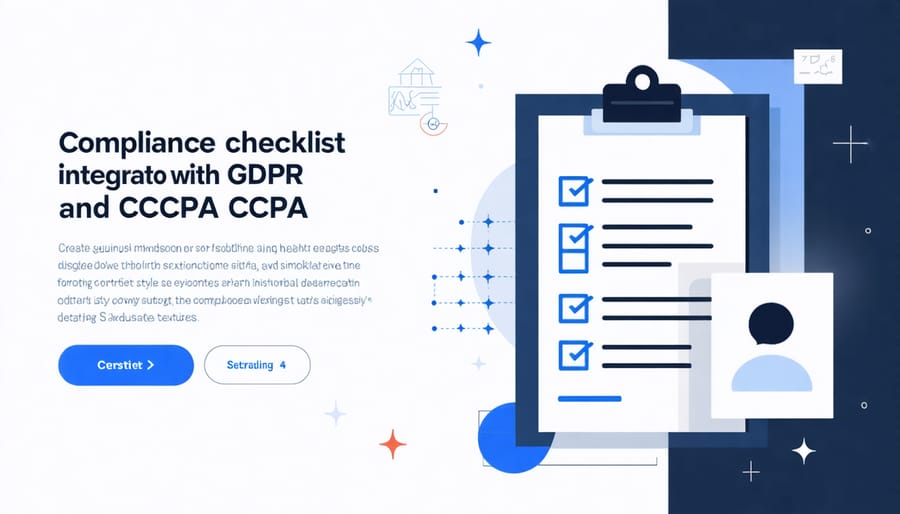How AI Transforms Marketing Privacy Analysis (Without Breaking Data Laws)

Privacy Impact Analysis templates transform raw data protection requirements into actionable marketing strategies while ensuring privacy compliance in AI systems. Map potential privacy risks across customer touchpoints, automate compliance workflows, and create standardized assessment procedures that protect both business interests and consumer data.
Modern marketing demands robust privacy frameworks that scale with technological advancement. This template system integrates seamlessly with existing marketing operations, providing clear documentation trails for audits while maintaining operational efficiency. Designed specifically for marketing professionals and business owners, it eliminates guesswork from privacy compliance and transforms complex regulations into manageable, actionable steps.
By implementing a structured privacy impact analysis template, organizations systematically identify potential privacy breaches before they occur, protect customer trust, and maintain competitive advantage in an increasingly privacy-conscious marketplace. The template serves as both a strategic planning tool and a practical implementation guide, ensuring consistent privacy standards across all marketing initiatives.

Building Your AI-Enhanced Privacy Impact Analysis Framework
Data Collection Assessment Template
The Data Collection Assessment template serves as a structured framework for evaluating how your organization gathers and processes personal information. Begin by listing all data collection touchpoints, including web forms, email subscriptions, and customer surveys. For each collection method, document:
1. Purpose of collection
2. Types of personal data collected
3. Storage location and duration
4. Access controls and security measures
5. Third-party sharing requirements
Create a risk scoring matrix (Low, Medium, High) for each data point based on:
– Sensitivity of information
– Volume of data collected
– Potential impact on individual privacy
– Regulatory compliance requirements
– Security vulnerabilities
Include specific assessment questions such as:
– Is this data necessary for business operations?
– Are there less invasive alternatives?
– How is consent obtained and documented?
– What data minimization strategies are in place?
Document your findings in a centralized spreadsheet or database, with columns for risk levels, mitigation strategies, and review dates. Update this assessment quarterly or when implementing new data collection methods to maintain compliance and protect customer privacy.
Privacy Risk Scoring Matrix
A robust privacy risk scoring matrix helps quantify potential privacy threats using a systematic approach enhanced by AI capabilities. The matrix typically employs a 5×5 grid that evaluates both the likelihood and impact of privacy risks on a scale from 1 (minimal) to 5 (severe).
To implement this scoring system, start by assessing the likelihood of each identified privacy risk. AI algorithms can analyze historical data patterns and industry trends to provide more accurate probability scores. Next, evaluate the potential impact of each risk on your stakeholders, considering factors like data sensitivity, number of affected individuals, and potential financial losses.
Multiply the likelihood score by the impact score to generate a final risk rating. For example, a risk with a likelihood of 4 and impact of 3 would receive a total score of 12. Use these thresholds as guidelines:
– 1-8: Low Risk (Monitor)
– 9-15: Medium Risk (Address within 6 months)
– 16-25: High Risk (Immediate action required)
Automated tools can help maintain and update this scoring system by continuously monitoring data flows and privacy compliance metrics, allowing for real-time risk assessment and proactive mitigation strategies.
AI-Powered Privacy Risk Detection
Automated Data Flow Mapping
Modern marketing systems generate vast amounts of data flows that require careful tracking and documentation for privacy compliance. AI-powered data analysis streamlines this process by automatically mapping how customer information moves through your marketing ecosystem.
These automated systems continuously monitor data touchpoints, creating visual representations of data flows between different marketing tools, databases, and third-party integrations. The mapping process identifies key elements such as data collection points, storage locations, processing activities, and data sharing relationships.
Key benefits of automated data flow mapping include:
– Real-time visibility into data movement patterns
– Automatic detection of unauthorized data access or sharing
– Instant alerts for potential privacy compliance issues
– Documentation of data retention periods and deletion processes
– Tracking of cross-border data transfers
The system maintains an updated inventory of all data processing activities, making it easier to respond to privacy audits and demonstrate compliance with regulations like GDPR and CCPA. It also helps identify potential vulnerabilities in your data handling processes before they become compliance issues.
For marketing teams, this automation reduces the manual effort required for privacy impact assessments while ensuring more accurate and comprehensive documentation of data flows. The resulting maps serve as valuable tools for privacy planning and risk mitigation strategies.

Predictive Risk Analysis
Modern privacy impact analysis has evolved beyond reactive measures, incorporating predictive AI technologies to identify and mitigate potential privacy concerns before they materialize. By leveraging machine learning algorithms, businesses can now analyze patterns in data handling practices and forecast potential AI privacy risks with remarkable accuracy.
This predictive approach typically involves three key components: historical data analysis, real-time monitoring, and future scenario modeling. The system examines past privacy incidents and near-misses, continuously monitors current data processing activities, and simulates various risk scenarios to identify vulnerabilities.
For marketing teams, this means being able to:
– Predict potential data breaches based on current handling practices
– Identify high-risk data processing activities before implementation
– Forecast the impact of new marketing technologies on customer privacy
– Anticipate regulatory compliance issues before they occur
The system generates risk probability scores for different marketing activities and provides actionable recommendations for risk mitigation. This proactive stance helps organizations maintain compliance while optimizing their marketing operations.
To implement predictive risk analysis effectively, organizations should:
1. Define clear risk indicators and thresholds
2. Establish automated monitoring protocols
3. Create response protocols for different risk levels
4. Regularly update the prediction models with new data
This forward-looking approach significantly reduces the likelihood of privacy incidents while strengthening customer trust and regulatory compliance.
Compliance Integration Checklist

GDPR Alignment Steps
To ensure GDPR compliance in your privacy impact analysis, follow these essential alignment steps. Start by documenting the legal basis for data processing activities, clearly identifying whether you’re relying on consent, contractual necessity, or legitimate interests. Map all data flows and establish records of processing activities (ROPAs) that detail what personal data you collect, how it’s used, and where it’s stored.
Implement data minimization principles by collecting only necessary information and setting appropriate retention periods. Create procedures for handling data subject rights, including access requests, erasure requests, and data portability. Establish clear protocols for obtaining and managing consent, ensuring it’s freely given, specific, informed, and unambiguous.
Review and update your data protection measures, including encryption, access controls, and backup procedures. Develop breach notification procedures that align with GDPR’s 72-hour reporting requirement. Train staff on GDPR requirements and their role in maintaining compliance.
Document all privacy-enhancing measures and maintain evidence of compliance. Regular reviews of these measures ensure ongoing alignment with GDPR requirements. Consider appointing a Data Protection Officer (DPO) if your processing operations require regular and systematic monitoring of data subjects on a large scale.
Finally, establish procedures for conducting Data Protection Impact Assessments (DPIAs) when introducing new technologies or processing activities that may pose high risks to individuals’ privacy.
CCPA Requirements Integration
The CCPA requirements must be carefully integrated into your privacy impact analysis template to ensure compliance with California’s stringent data protection laws. Start by including specific sections that address the collection, storage, and processing of California residents’ personal information. Your template should explicitly document how your organization handles CCPA-specific consumer rights, including the right to know, delete, and opt-out of data sales.
Include checkboxes or assessment points that verify whether your data processing activities fall under CCPA jurisdiction, particularly if you handle data from more than 50,000 California consumers annually or derive more than 50% of revenue from selling personal information. The template should also address the 12-month lookback period requirement and verify that your systems can promptly respond to consumer requests within the mandated 45-day timeframe.
Consider adding sections that evaluate third-party vendor compliance with CCPA requirements, especially for data processors and service providers. Document your methods for obtaining and managing consumer consent, particularly for minors under 16. Finally, ensure your template includes mechanisms to track and document any updates to your CCPA compliance measures, as regulations continue to evolve with the introduction of CPRA amendments.
Implementation and Monitoring
Successful implementation of your privacy impact analysis template requires a structured approach and consistent monitoring. Begin by establishing a dedicated implementation team responsible for overseeing the process and ensuring all stakeholders understand their roles. Create a timeline with clear milestones and deadlines for each phase of the analysis.
Set up automated monitoring systems to track data collection points and privacy compliance metrics. These systems should integrate with your existing marketing intelligence insights to provide comprehensive oversight of privacy practices.
Develop a reporting schedule that includes:
– Weekly progress updates
– Monthly compliance checks
– Quarterly assessment reviews
– Annual comprehensive audits
Implement a feedback loop system where employees can report privacy concerns or suggest improvements. This creates a culture of privacy awareness and continuous improvement. Regular training sessions should be conducted to keep team members updated on privacy best practices and any template modifications.
Document all implementation steps and monitoring results in a centralized dashboard. This ensures transparency and makes it easier to demonstrate compliance during audits. Set up automatic alerts for potential privacy breaches or significant deviations from established protocols.
Review and update the template regularly based on:
– Changes in privacy regulations
– New business processes
– Technological advancements
– Stakeholder feedback
– Risk assessment outcomes
Remember to maintain clear communication channels with all parties involved and establish an escalation protocol for privacy-related incidents. This proactive approach helps ensure the template remains effective and adaptable to changing privacy requirements.
Implementing AI-enhanced privacy impact analysis represents a significant step forward in protecting both your business and customer data. By following the templates and frameworks outlined in this guide, you’re well-positioned to create a robust privacy assessment process that’s both efficient and thorough.
Remember to regularly review and update your privacy impact analysis procedures as technology evolves and regulations change. Start by implementing the basic template, then gradually incorporate AI tools to automate data collection and analysis. This staged approach ensures a smooth transition while maintaining accuracy and compliance.
Key next steps include:
– Training your team on the new privacy analysis procedures
– Setting up automated monitoring systems
– Establishing regular review cycles
– Creating feedback loops for continuous improvement
– Documenting all privacy-related decisions and their rationales
Stay proactive by scheduling quarterly assessments of your privacy impact analysis framework. This helps identify potential gaps and opportunities for enhancement. Consider working with privacy professionals to validate your approach and ensure you’re leveraging AI capabilities effectively.
Most importantly, maintain open communication with stakeholders about your privacy measures. This transparency builds trust and demonstrates your commitment to protecting sensitive information. As AI technology continues to advance, your privacy impact analysis framework should evolve accordingly, always prioritizing data protection while supporting business growth.
Leave a Reply